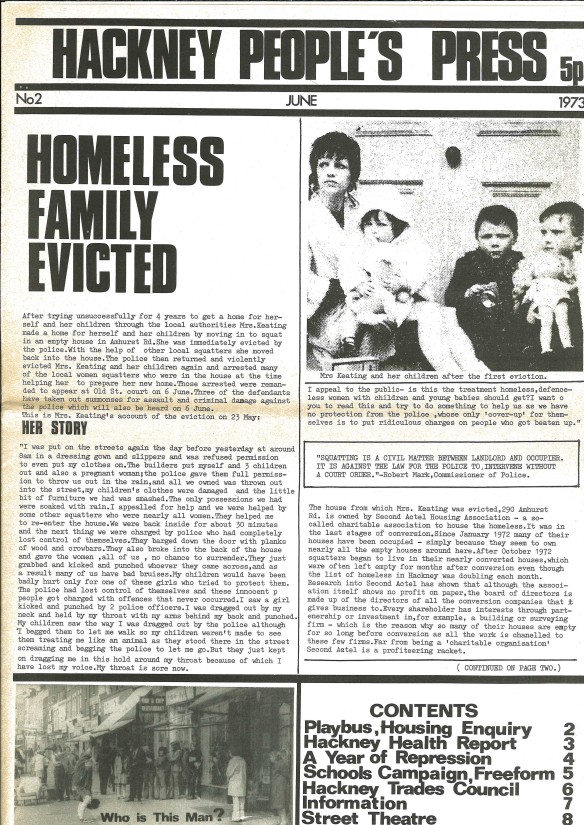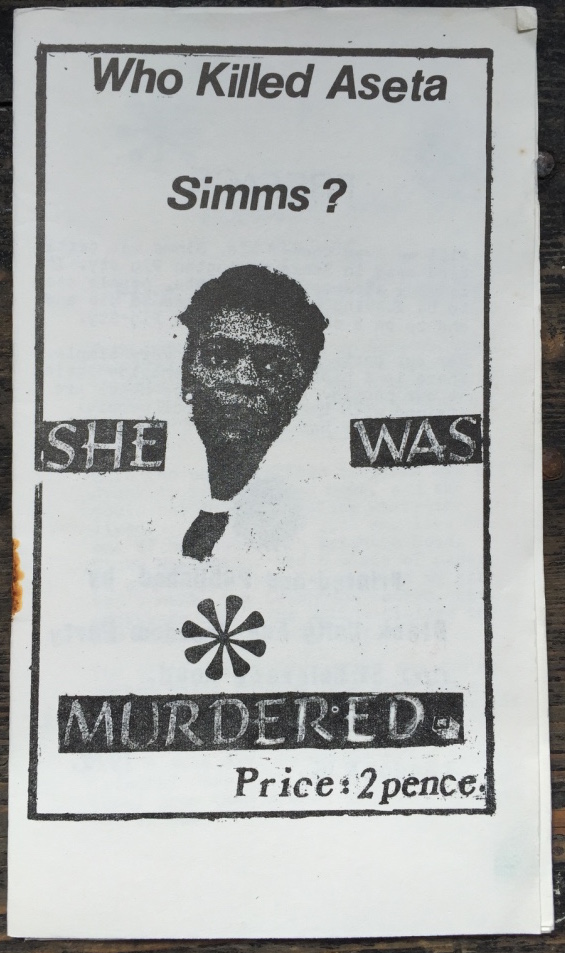
A small (A6ish) pamphlet published by the Black Unity and Freedom Party in 1972. Also available as a PDF here.
There is an overview of the history of the BUFP by Professor Harry Goulbourne here. Ken Worpole mentions the group having regular street sales in Ridley Road market.
Aseta Simms is one of an inexcusably large number of people to have died in suspicious circumstances in Stoke Newington police station. Mrs Simms’ death was also a front page story in Hackney Gutter Press.
Aseta Simms is often mentioned in lists of deaths in police custody but it’s harder to find the context. The text is reproduced below (with some small corrections for consistency etc) alongside the original pages so you can see the presentation of the original.
PREFACE
Will we ever know? Mrs Simms was certified dead in Stoke Newington Pig sty. It is very strange that of late, people seem to be leaving everywhere else to die and end up on a cold slab in the Pig-Sty. For our part, the answer is very simple. There is a plot to commit Genocide against our people. The pig-police hands are stained with the blood of our people. They are the hatchet men of the racist fascists.
Printed and Published by Black Unity And Freedom Party c/o 31, Belgrade Road, Stoke Newington, ISSUE No.1. London N.16. 1972.
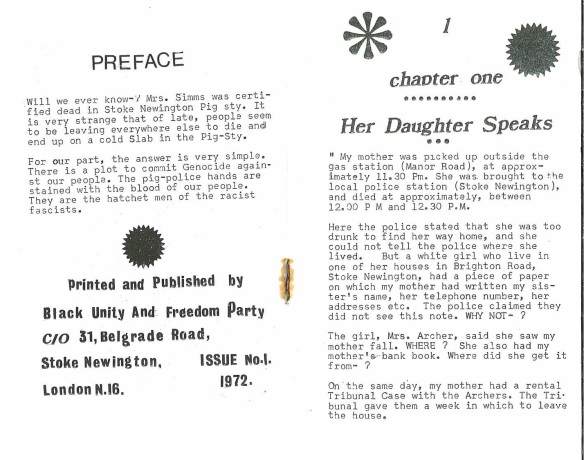
CHAPTER ONE
Her Daughter Speaks
“My mother was picked up outside the gas station (Manor Road), at approximately 11.30pm. She was brought to the local police station (Stoke Newington), and died at approximately, between 12.00pm and 12.30pm [Hackney Gutter press (link above) report this as having happened on 13th May 1971. The later times in this sentence should probably read 12:00am and 12:30am, i.e the early hours of the 14th May – Radical History of Hackney note].
Here the police stated that she was too drunk to find her way home, and she could not tell the police where she lived. But a white girl who live in one of her houses in Brighton Road, Stoke Newington, had a piece of paper on which my mother had written my sister’s name, her telephone number, her addresses etc. The police claimed they did not see this note. WHY NOT?
The girl, Mrs Archer, said she saw my mother fall. WHERE? She also had my mother’s bank book. Where did she get it from?
On the same day, my mother had a rental Tribunal Case with the Archers. The Tribunal gave them a week in which to leave the house.
Mrs Archer said that my mother was drunk. How did she know? Mr. Archer said that my mother and his wife left the house at the same time and went to the Off Licence. He said further that my mother bought a bottle of Whisky and his wife bought a bottle of Guinness. He showed me the bottle of Guinness. But in the afternoon my mother had bought a bottle of whisky. So therefore; she couldn’t have bought a bottle of whisky when Mr Archer said so.
The police said they laid my mother on her tummy, so if she was sick, it would not stifle her. They said they watched her until she died. What did she say before she died? NO ONE KNOWS!
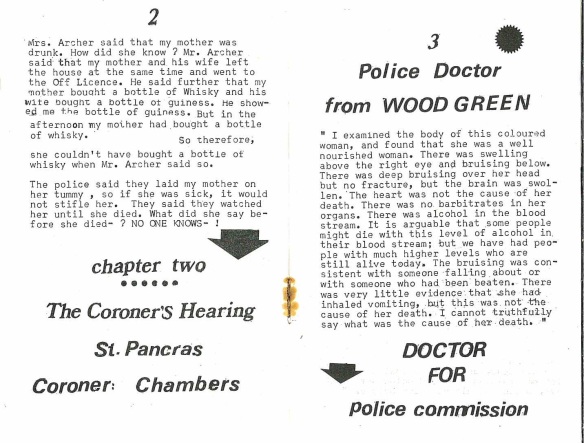
CHAPTER TWO
The coroner’s Hearing St. Pancras
Coroners Chambers
Police Doctor from WOOD GREEN
“I examined the body of this coloured woman, and found that she was a well-nourished woman. There was swelling above the right eye and bruising below. There was deep bruising over her head but no fracture, but the brain was swollen. The heart was not the cause of her death. There was no barbitrates in her organs. There was alcohol in the blood stream. It is arguable that some people might die with this level of alcohol in their blood stream; but we have had people with much higher levels who are still alive today. The bruising was consistent with someone falling about or with someone who had been beaten. There was very little evidence that she had inhaled vomiting, but this was not the cause of her death. I cannot truthfully say what was the cause of her death.”
DOCTOR FOR Police commission
“I received two samples said to be taken from the body of this dead coloured woman: Samples of blood and whisky. The blood samples showed 479ml grammes of alcohol and this concentration may be considered lethal; but there is no firmly established level to equate with death. The level found in the blood samples could only have arisen if a full bottle of whisky was drunk quickly.”
EIder DAUGHTER Says
“I saw my mother last alive at 2.00pm on 13/5/71, it was polling day of the local council elections. She was sober and alright. She had eaten some fish and chips earlier on. About once every other week my mother would buy some drinks. My mother was fine and healthy. I knew my mother died while in police custody. I saw her at St. Leonards hospital after she was dead, and noticed that she had a lot of bruising over and below her right eye, which she did not have before.”
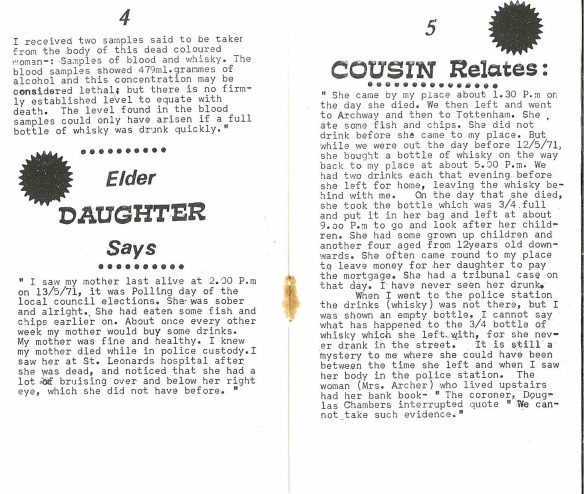
COUSIN Relates
“She came by my place about 1.30pm on the day she died. We then left and went to Archway and then to Tottenham. She ate some fish and chips. She did not drink before she came to my place. But while we were out the day before 12/5/71, she bought a bottle of whisky on the way back to my place at about 5.00pm. We had two drinks each that evening before she left for home, leaving the whisky behind with me. On the day that she died, she took the bottle which was 3/4 full and put it in her bag and left at about 9.00pm to go and look after her children. She had some grown up children and another four aged from 12 years old down-wards. She often came round to my place to leave money for her daughter to pay the mortgage. She had a tribunal case on that day. I have never seen her drunk. When I went to the police station the drinks (whisky) was not there, but I was shown an empty bottle. I cannot say what has happened to the 3/4 bottle of whisky which she left with, for she never drank in the street. It is still a mystery to me where she could have been between the time she left and when I saw her body in the police station. The woman (Mrs. Archer) who lived upstairs had her bank book”
The coroner, Douglas Chambers interrupted quote “We can-not take such evidence.”
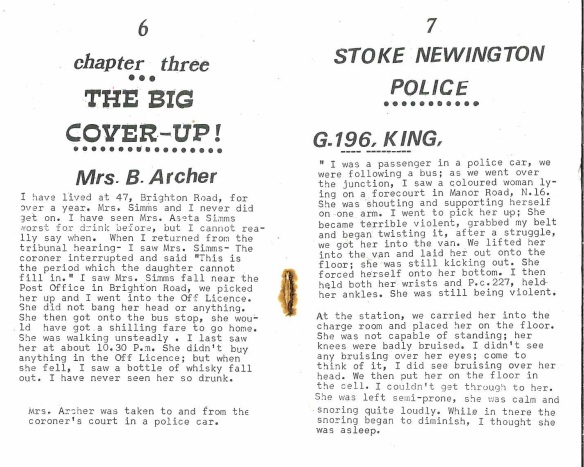
CHAPTER THREE
THE BIG COVER-UP!
Mrs B. Archer
“I have lived at 47, Brighton Road, for over a year. Mrs Simms and I never did get on. I have seen Mrs Aseta Simms worst for drink before, but I cannot really say when. When I returned from the tribunal hearing I saw Mrs Simms..”
The coroner interrupted and said “This is the period which the daughter cannot fill in.”
“I saw Mrs Simms fall near the Post Office in Brighton Road, we picked her up and I went into the Off Licence. She did not bang her head or anything. She then got onto the bus stop, she would have got a shilling fare to go home. She was walking unsteadily. I last saw her at about 10.30pm. She didn’t buy anything in the Off Licence; but when she fell, I saw a bottle of whisky fall out. I have never seen her so drunk.
Mrs Archer was taken to and from the coroner’s court in a police car.
STOKE NEWINGTON POLICE
G.196, KING
“I was a passenger in a police car, we were following a bus; as we went over the junction, I saw a coloured woman lying on a forecourt in Manor Road, N16. She was shouting and supporting herself on one arm. I went to pick her up; She became terrible violent, grabbed my belt and began twisting it, after a struggle, we got her into the van. We lifted her into the van and laid her out onto the floor; she was still kicking out. She forced herself onto her bottom. I then held both her wrists and P.C.227, held her ankles. She was still being violent.
At the station, we carried her into the charge room and placed her on the floor. She was not capable of standing; her knees were badly bruised. I didn’t see any bruising over her eyes; come to think of it, I did see bruising over her head. We then put her on the floor in the cell. I couldn’t get through to her. She was left semi-prone, she was calm and snoring quite loudly. While in there the snoring began to diminish, I thought she was asleep.
I went back to arouse her, but I could not. Sergeant Barker and I then tried to give her respiration but failed. An ambulance was then sent for. We did not send for any doctor. She was not lying on anything; just the bare floor.”
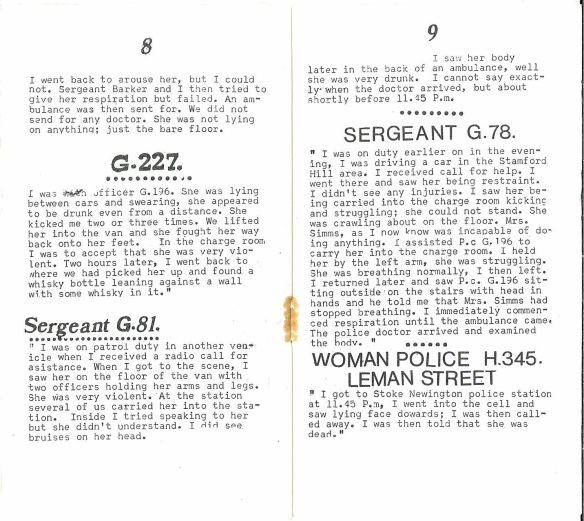
G.227.
“I was with officer G.196. She was lying between cars and swearing, she appeared to be drunk even from a distance. She kicked me two or three times. We lifted her into the van and she fought her way back onto her feet. In the charge room I was to accept that she was very violent. Two hours later, I went back to where we had picked her up and found a whisky bottle leaning against a wall with some whisky in it.”
Sergeant G.81.
“I was on patrol duty in another vehicle when I received a radio call for assistance. When I got to the scene, I saw her on the floor of the van with two officers holding her arms and legs. She was very violent. At the station several of us carried her into the station. Inside I tried speaking to her but she didn’t understand. I did see bruises on her head.
I saw her body later in the back of an ambulance, well she was very drunk. I cannot say exactly when the doctor arrived, but about shortly before 11.45pm.”
Sergeant G.78.
“I was on duty earlier on in the evening, I was driving a car in the Stamford Hill area. I received call for help. I went there and saw her being restraint. I didn’t see any injuries. I saw her being carried into the charge room kicking and struggling; she could not stand. She was crawling about on the floor. Mrs Simms, as I now know was incapable of doing anything. I assisted P.C. G.196 to carry her into the charge room. I held her by the left arm, she was struggling. She was breathing normally, I then left. I returned later and saw P.C. G.196 sitting outside-on the stairs with head in hands and he told me that Mrs. Simms had stopped breathing. I immediately commenced respiration until the ambulance came. The police doctor arrived and examined the body.”
WOMAN POLICE H.345. LEMAN STREET
“I got to Stoke Newington police station at 11.45pm, I went into the cell and saw lying face downwards; I was then called away. I was then told that she was dead.”

INSPECTOR
“I was on duty and I saw events as stated and knew. I did not know the deceased. The doctor was sent for at 11.55pm. Doctor arrived same time as the ambulance. It was normal procedure to have drunken people in that manner. Tries were made to get other doctors before but this failed. ”
The CORONER retired with the jury
“She was violent. She died with an amount of alcohol in her blood stream. The Home office says that the coroner has a choice to sit or not to sit with the jury in special circumstances. There are special circumstances in this hearing, therefore under the Home office rules for coroners’ courts, I shall sit with the jury .
How, when, where or why the person or persons should be charged with murder or manslaughter; under the circumstances, there is no such accusation. No question of the verdict to have civil liabilities . A rider could be put in to prevent repetition of this kind of deaths. Some reasonable people would assume that the bottle found, was the same one from which she had consumed whisky until she was found between the cars. She could not be charged because she could not have understood.”
Verdict
“The verdict is death by misadventure, there is no rider.”
CHAPTER THREE
Conclusion
WE DEMAND AN IMMEDIATE PUBLIC ENQUIRY IN TO THE BRUTAL RACIST ACTIVITIES OF THE POLICE AGAINST BLACK PEOPLE.
We know this Black sister Mrs Simms was murdered by the racist police. This much we have no doubt of. In the face of the evidence given at the coroner’s court held on 10/6/71, at St Pancras. The coroner, Douglas Chambers went and sat with the jury; claiming he had power to do so under some unknown Home Office rules. Now ask yourselves, why did he found it necessary to sit with the jury? The smell left from this inquest bears too potent a stench to be tolerate, even by the greatest appeasement inclination.
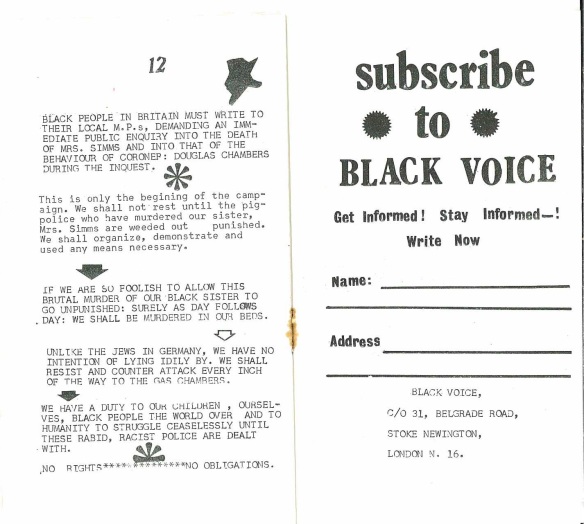
BLACK PEOPLE IN BRITAIN MUST WRITE TO THEIR LOCAL MPs, DEMANDING AN IMMEDIATE PUBLIC ENQUIRY INTO THE DEATH OF MRS. SIMMS AND INTO THAT OF THE BEHAVIOUR OF CORONER DOUGLAS CHAMBERS DURING THE INQUEST.
This is only the beginning of the campaign. We shall not rest until the pig-police who have murdered our sister, Mrs Simms are weeded out punished. We shall organize, demonstrate and use any means necessary.
IF WE ARE SO FOOLISH TO ALLOW THIS BRUTAL MURDER OF OUR BLACK SISTER TO GO UNPUNISHED: SURELY AS DAY FOLLOWS DAY: WE SHALL BE MURDERED IN OUR BEDS.
UNLIKE THE JEWS IN GERMANY, WE HAVE NO INTENTION OF LYING IDILY BY. WE SHALL RESIST AND COUNTER ATTACK EVERY INCH OF THE WAY TO THE GAS CHAMBERS. [NB: I don’t think this point is well made – there was significant Jewish and other resistance to the Nazis. Also, as a bad as 1970s Hackney was, a comparison to Nazi Germany, gas chambers etc is well over the top – Radical History of Hackney note]
WE HAVE A DUTY TO OUK CHILDREN , OURSELVES, BLACK PEOPLE THE WORLD OVER AND TO HUMANITY TO STRUGGLE CEASELESSLY UNTIL THESE RABID, RACIST POLICE ARE DEALT WITH.
NO RIGHTS – NO OBLIGATIONS.
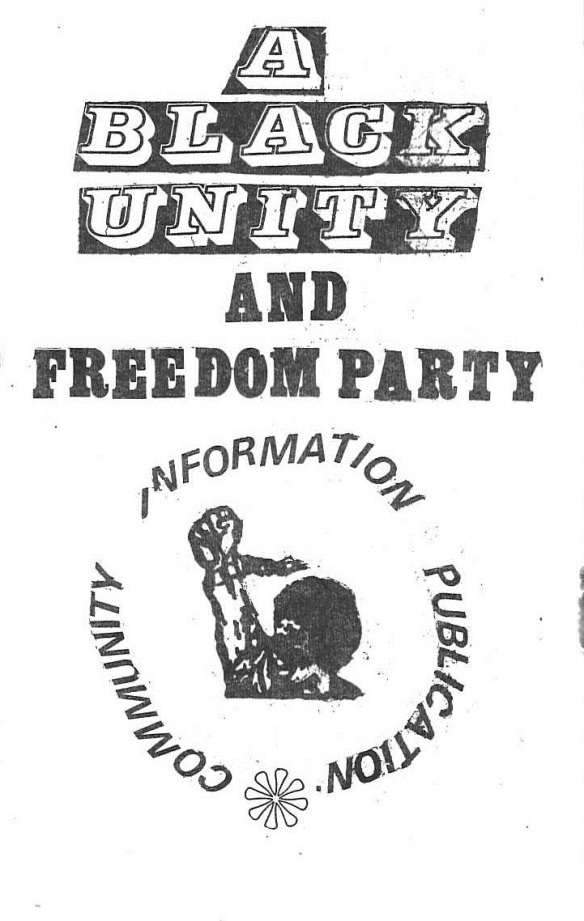
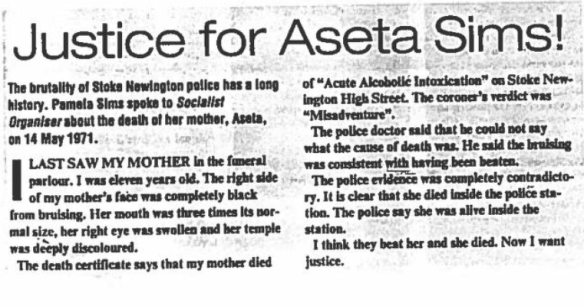
Press cutting from April 1993 – possibly Socialist Organiser
Aseta commemorated on a Hackney Community Defence Association banner, as seen at a meeting about Spycops earlier this year:















